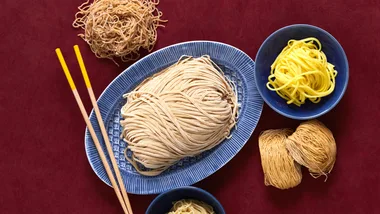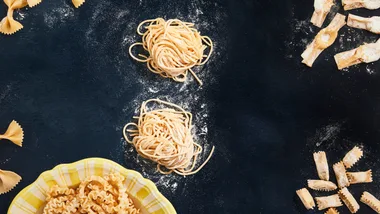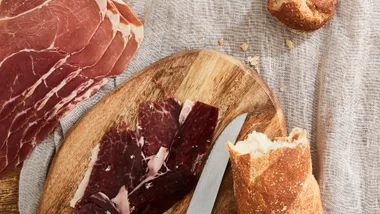There’s something to be said for a stage name to build hype and help sell an act. How many records, for example, would Ice-T have sold under his given name, Tracy Marrow? Would “Ice Ice Baby” have been such a hit if it was by an artist named Robert Van Winkle? But a name will only get you so far; it needs to be backed up by substance. The same rings true in the vegetable world. Consider the red beard onion: killer name backed up by solid qualities.
The red beard is a variety of bunching onion that originated in China and Kazakhstan from wild members of the allium family, arriving in Europe in the Middle Ages and in England in the 17th century. It’s a hardy, fast-growing onion that is perfectly suited to home gardens.
More often known as a spring onion, the red beard has a stalk that’s tinged red and grows to around 12 centimetres long and 1.5 centimetres wide; the plant grows to around 60 centimetres tall. With green foliage and a pleasing mild flavour, they’re perennial but grown mostly as an annual.
Add red beard onion to our stir-fry recipes.
When growing the red beard from seed, ensure your soil is well draining and well integrated with compost. The seeds are tiny so tweezers are a good idea for planting. Form shallow trenches, no more than a centimetre deep, and sow a seed every three to four centimetres. Keep the soil damp throughout the germination process and you should see little babies pop up in seven to 10 days.
If you’re propagating the red beard onion from seedling, its hardiness will become apparent. Rather than separating seedlings and planting each in its own hole, lay them flat on the ground with the roots in a trench line two to three centimetres deep and cover them with soil. After a few days of watering, the seedlings will shoot new roots that will help them stand tall and reach for sunlight.
As with any edible plant, full sun is preferable, but these onions will also do well in partially shaded areas. Make sure to keep them well watered throughout their life cycle, which means watering every day or two, depending on weather conditions and, of course, frequently and regularly when growing in pots.
Companion planting red beard onions with chamomile and carrots is a good idea. Chamomile will help increase the scent of the onion and deter soil-borne pests, while carrots will lessen the chance of aphid infestation. This is particularly useful if you’re growing them in early spring when this pest is on the march.
The seedlings are fast growing – they’ll establish themselves quickly and be ready to harvest in no more than two months, even earlier if all the stars are aligned. When harvesting them, rather than pulling out the entire onion, it’s best to cut them at the base of the stem, just above the roots, with a sharp knife or scissors – this allows the root zone to regenerate and produce the next crop.
Within a few days of the cut you’ll notice a new shoot sprouting, and a few weeks after that round two will be on. Perpetual harvesting in this manner is possible until the onions turn slimy or go to seed. At this point, collect the next generation of red beards by cutting mature flower heads and drying them.
While our classic, slow-burning, bulbing onion is best used in European cooking, the red beard’s natural home is in Asian cuisine. Quick and punchy stir-fries and soups are the perfect destinations for this quick-growing vegetable.










